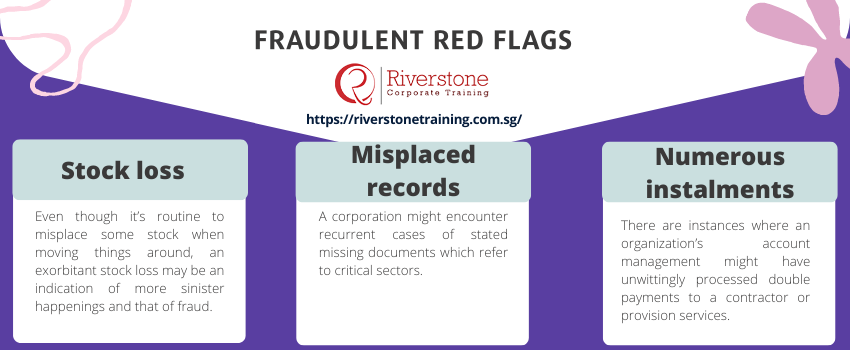
What are Fraudulent Red Flags?
The common Fraudulent red flags of fraud speak to circumstances that systematically add to fraud and cozenage in a multitude of companies and sectors. When there is an investigation or review of the company’s inventory or financial year certain distinguishing and detrimental traits tend to be seen as the common Fraudulent red flags of fraud!
All commodities and consortium are confronted with the risk of fraud, domestic and foreign. Domestic risks come from within the consortium’s, from the people who use their status to leverage, by infringing upon assets endowed by the firm. Whereas foreign risks are structured by civil servants, consumers, and vendors who might distort the facts.
https://quickbooks.intuit.com/r/bookkeeping/8-red-flags-you-can-spot-on-your-financial-statements/
Pls add the 5-6 points red flags from the link-
Warnings of Fraud (red flags):
There is a myriad of Fraudulent red flags that any accounting professional should consider when openly investigating fraud within a company. These consist of:
Stock loss:
Even though it’s routine to misplace some stock when moving things around, an exorbitant stock loss may be an indication of more sinister happenings and that of fraud. Stock loss can be uncovered by an examiner by looking at the budget, the number of products that are still in the inventory and compare those numbers to the amount of stock sold according to the records then compare your findings with the prior report and predictions.
Misplaced records:
A corporation might encounter recurrent cases of stated missing documents which refer to critical sectors. When the prevalence of this is too frequent, it may an indicator fraud.
Numerous instalments:
There are instances where an organization’s account management might have unwittingly processed double payments to a contractor or provision services. If this oversight was honest, the officials implicated in overcoming these issues.
Nevertheless, there can be instances where certain workers espouse double payments to false organizations. To deter this, all these payments should be controlled and ascertained that all the payments are going to the correct outfits.
Increases in invoices:
A venture in its expanding phase may acknowledge immense increases in the number of invoices as it tries to make an impact on the market. Nonetheless, the lofty number of invoices engenders room for fraud. These particular individuals solicit the need to profit from the expedited expansion of the firm.
Frequent questions/complaints:
Habitual grievances about particular employees may be an indication of fraud. When a company gets multiple accusations about a higher-up official, The auditor should not assume that as water-cooler talk. In its place, they should action an investigation to establish the reason for the accusation.
Adjusted entries:
Some enumeration offices may make excessive adjustments to their entries in the book-keeping as a way to shroud some of the money misapplications in the past.
Making exorbitant adaptations without purpose, this points to instances of the worker’s fraud to conceal specific deeds. A volume of fraud that is poignant to the organization occurs from within the organization in of itself, mainly from workers.
Conclusion:
Even the most process-driven organizations are at risk for fraud. To find this “needle in a haystack” and deal with fraudulent behaviour, you must first accept that fraud very much exists and that it occurs often. Recognize the importance of fraud awareness and implement training for employees on how to detect fraud at work.



